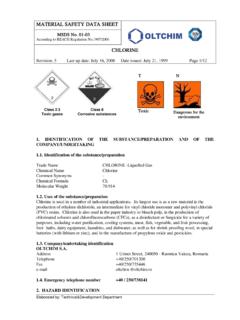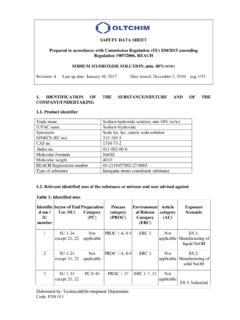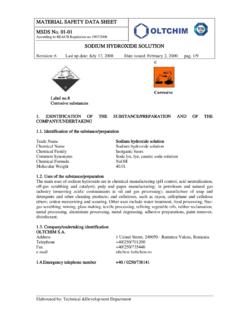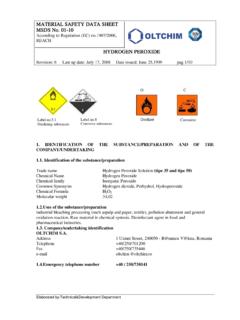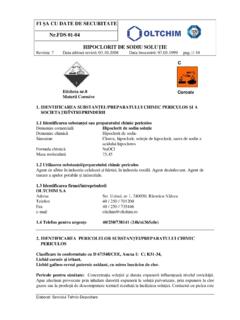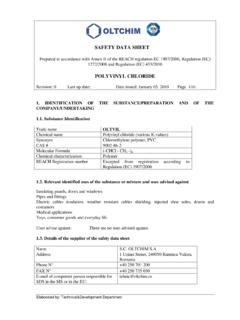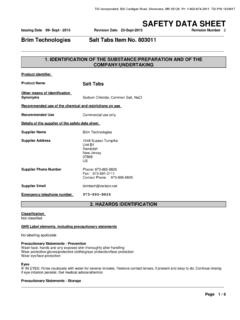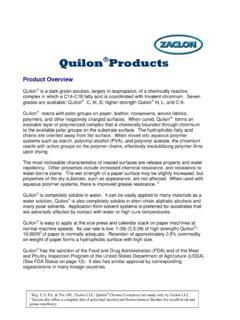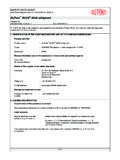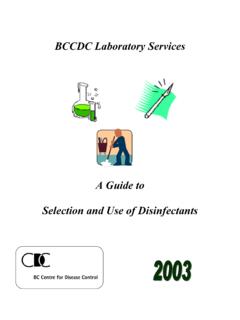Transcription of HYDROCHLORIC ACID, SOLUTION min. 32% - …
1 MATERIAL SAFETY DATA SHEET MSDS No. 01-05 According to REACH Regulation acid , SOLUTION min. 32%Revision: 6 Last up date: July 17, 2008 Date issued: July 21,1999 Page1/10 Elaborated by: Technical&Development Department1. IDENTIFICATION OF THE SUBSTANCE/PREPARATION AND OF Identification of the substance/preparationTrade NameHydrochloric acidChemical NameHydrochloric acid 32%, aqueousCommon SynonymsMuriatic acid , Hydrogen chloride,. Uses of the substance/preparationHydro chlo ric acid is used in the productio n o f chlorides, for refining o re in the productio n o f tin andtantalum, for pickling and cleaning of metal products, in electroplating, in removing scale fromboilers, for the neutralization of basic systems, as a laboratory reagent, as a catalyst and solvent inorganic syntheses, in the manufacture of fertilizers and dyes, for hydrolyzing starch and proteins inthe preparation of various food products, and in the textile and rubber Company/undertaking identificationOLTCHIM Uzinei Street, 240050 - Ramnicu Valcea, RomaniaTelephone+40/250/701200 Fax+40/250/735446e-mailo ltchim Emergency telephone number+40 / (0)250/738141 Class 8 Corrosive substancesCCorrosiveHYDROCHLORIC acid , SOLUTION min.
2 32%MSDS No. 01-05 Revision: 6 Last up date: July 17, 2008 Date issued: July 21,1999 Page2/102. HAZARD IDENTIFICATIONEC Classification according to Directive 67/548/CEE, Annex IC; R35 Corrosive, fuming to respiratory effects: CORROSIVE! Contact can cause severe skin and eye burns, leading to permanentdamage with loss of light. Breathing the vapors can irritate the mouth, nose, and throat. High levelsmay irritate the lungs, causing coughing and/or shortness of breath. Higher exposure can cause abuildup of fluid of the lungs (pulmonary edema), a medical emergency. Overexposure may causeerosion of the effects: Considering its high water solubility, HYDROCHLORIC acid is not expected tobioaccumulate in organism. HYDROCHLORIC acid is slightly toxic in the aquatic environment. The toxiceffect on aquatic organism is due pH decreasing. When released into the soil this material may leachinto groundwater.
3 During movement through soil, the carbonates will be decomposed andneutralized by HYDROCHLORIC acid . HYDROCHLORIC acid is not classified as dangerous for environmentalas specified in Directive 67/548/EEC, Annex Overview:Colorless or slight yellow liquid with sharp, pungent odor, fume in air, verycorrosive. Reacts with most metals in a corrosive manner liberating flammable hydrogen gas,(explosive limits in air: 4 - 75%). Will not burn in fire, but may generate chlorine COMPOSITION/ INFORMATION ON INGREDIENTSH azardouscomponents/constituentsConcentra tion% (v/v) No. Annex I ChlorideMin. 32-231-595-7017-002-01-XCR 34R 374. FIRST - AID MEASURESSeek medical attention immediately in all cases of exposure!Inhalation:Inhalation of HYDROCHLORIC acid at irritating concentrations causes coughing, pain,inflammation, and edema of the upper respiratory tract. At high concentration, the gas causesnecrosis of the bronchial epithelium, constriction of the larynx and bronchi, and closure of the of the 1000 to 2000 ppm and higher are immediately from exposure area to fresh air.
4 If not breathing, clear airway and start artificialresuscitation. Get immediate medical attention. If victim is having trouble breathing, transport tomedical care and, if available, give supplemental oxygen. Keep the patient under medical observationfor a least 24 acid , SOLUTION min. 32%MSDS No. 01-05 Revision: 6 Last up date: July 17, 2008 Date issued: July 21,1999 Page3/10 Skin contact:Corrosive. Exposure to HYDROCHLORIC acid can produce burns on the skin and mucousmembranes, the severity of which is related to the concentration of the SOLUTION . Subsequently,ulceration may occur, followed by keloid and retractile flush skin with plenty of water for at least 15 minutes, while removing contaminatedclothing and shoes. Get immediate medical attention. Wash clothing and contaminated shoes contact: Contact of conc acid with the eye can cause extensive necrosis of the conjunctiva andcorneal epithelium, resulting in perforation or opaque scarring.
5 Frequent contact with aqueoussolutions of HYDROCHLORIC acid may lead to contaminated eye(s) with plenty of waterfor at least 15 minutes. Remove any contact lenses. Hold eyelids apart to ensure rinsing of the entiresurface of the eyes and lids with water. If physician is not available, flush for an additional 15minutes. Get immediate medical :Corrosive. Symptoms after ingestion include immediate pain and ulceration of allmembranes and tissues which come in contact with the acid . Ingestion may be associtated withnausea, vomiting and intense thirst; corrosion of the stomach may lead within a few hours or a fewdays to gastric perforation and peritonitis. Late esophageal, gastric and pyloric strictures andstenoses should be anticipated. If any acid is swallowed, it should be neutralized by gastric lavagewith 5% Na2CO3 SOLUTION , followed by a drop of aluminum hydroxide. DO NOT INDUCEVOMITING! Do not give anything by mouth to an unconscious or convulsing person.
6 Getimmediate medical advice: HYDROCHLORIC acid it is very corrosive and irritating and may cause severe burns andmay be fatal if swallowed or inhaled. Do not get in eyes, or skin, on clothing! Do not breathe vapor!Keep in tightly closed FIRE - FIGHTING MEASURESE xtinguishing media:For small fires, use water spray, foam, carbon dioxide or dry chemical. Forlarge fires, use water spray, fog or alcohol of fire fighting:Fire fighters should wear full protective clothing and self-containedbreathing apparatus with face-piece operate in positive pressure mode. Stay away from ends oftanks. Cool tanks with water spray. Do not get water inside combustion products: information: HYDROCHLORIC acid is nonflammable, has not sensibility to mechanical shock andto static discharge. Contact with metals produces hydrogen gas, which may form explosive mixtureswith air. Thermal decomposition can produce poisoning acid reacts also withmany organic materials with liberation of acid , SOLUTION min.
7 32%MSDS No. 01-05 Revision: 6 Last up date: July 17, 2008 Date issued: July 21,1999 Page4/106. ACCIDENTAL RELEASE MEASURESP ersonal precautions: Wear appropriate protective equipment. Do not touch or walk throughspilled material. Stop leak if it can be done without risk. Evacuate all unnecessary personnel fromaffected area. Ventilate and isolate the hazard precautions: Prevent from contamination the ground and the surface water byisolating the work area. Contain and recover liquid when possible. Keep closed containers anddispose according to all applicable federal state or local environment of cleaning up:For small spills, use vermiculite, fuller s earth o r sand to absorb the with lime stone, slaked lime or soda ash. Shovel up and place in a non-metal wastecontainer for disposal. Neutralize spill area and washwith plent y o f water. Fo r large spills,dike spill area with soil or sandbags to contain it and to prevent it spread.
8 Prevent liquid fromentering sewers waterways; water spray can be used to knock down vapors. Remove bulk of liquid,for example with vacuum truck, for recovery or disposal. Then flush area with water and neutralizewashings with lime stone, slaked lime, soda ash or caustic. If permitted, flush neutralized washing toa waste treatment plant. Dispose of all contaminants according to federal, state and local AND STORAGEH andling:Protect containers against physical damage. Wear appropriate protective containers closed. Use with sufficient ventilation to keep area below established exposurelevels. Wash thoroughly after handling. When handle HYDROCHLORIC acid avoid contact with metalsand organic matters. When diluting, the acid should always be added slowly to water and in smallamounts. Never use hot water and never add water to the acid ! Water added to the acid can causeuncontrolled boiling and splashing. If opening metal containers, use non-sparking tools because ofthe possibility of hydrogen gas being present.
9 Containers of this material may be hazardous whenempty since they retain product residue (vapors, liquid); observe all warnings and precautions listedfor the productStorage:Store in a cool, dry, ventilated area with acid resistant floors and good drainage. Keep outof direct sunlight and away from heat, water and incompatible materials. Keep the containers tightlyclosed. Containers for HYDROCHLORIC acid must be made from corrosion resistant materials: glass,polyethylene, polypropylene, polyvinyl chloride, carbon steel lined with rubber or EXPOSURE CONTROLS / PERSONAL PROTECTIONE xposure limit:Long-term exposure limit (8-hour TWA reference period) for aerosol mist: 1 ppm (2 mg/m3)Short-term exposure limit (15-minute reference period):5 ppm (8 mg/m3) HYDROCHLORIC acid , SOLUTION min. 32%MSDS No. 01-05 Revision: 6 Last up date: July 17, 2008 Date issued: July 21,1999 Page5/10 Engineering control: Use local exhaust or general dilution ventilation system to keep employeeexposure as low as possible.
10 In plant operations should employ negative pressure (vacuum)techniques to keep vapor inside processing protective equipmentRespiratory protection:If the exposure limit is exceeded (up to 50ppm) a full face-piece respiratorwith a chemical cartridge respirator with acid cartridge is recommended. Above this level, aself-contained breathing apparatus is protection:Wear natural rubber, neoprene, chlorinated polyethylene or polyvinyl / Face protection:Use chemicalsafety goggles and/or a full face shield where splashing ispossible. Maintain eye wash fountain and quick-drench facilities inwork protection: Wear clothing (full suit) that will protect the skin from exposure to this emergency or while making repairs, wear clothing that will not allow this chemical topenetrate. An additional protection including impervious boots, apron or coverall, is needed in areasof unusual exposure to prevent skin PHYSICAL AND CHEMICAL PROPERTIESA ppearanceclear, colo rless or slightly yellow fuming liquidOdorpungent odorBo iling po int-840 CMelting point-1120 CFreezing for for solutionDensity (water=1) density (air=1) pressure19 mmHg, at 250 CSolubility in water 823 g/l at 0oC; 721g/l at 20oC; 561 g/l at 60oCOther solubility ssoluble in alcohol, benzene and ether, insoluble in hydrocarbonspH 1N( ); (.)
